التخطيط الاستراتيجي ورسم خرائط الطريق، والتسويق، والتنبؤ .. إدارة المنتجات ينطوي على الكثير من العمل
لحسن الحظ، مع وجود أدوات مثل Aha! لا يجب أن يكون الأمر أصعب بكثير من التخطيط لمشاهدة نيتفليكس ليلة الجمعة. يمكن لإدارة منتجات Aha أن تساعد الشركات التي ترغب في إطلاق منتجات ناجحة والحفاظ على سوقها.
ولكن هل ستجعلك هذه المنصة حقًا _تجعلك تشعر بالبهجة!
في مراجعة إدارة منتجات Aha هذه، سنناقش ميزات Aha! وإيجابياتها وقيودها الرئيسية. سنسلط الضوء أيضًا على أفضل حل ل قيود Aha! .
_جاهز؟ فقط اضغط على تشغيل مراجعة إدارة منتجات Aha هذه
ما هو Aha!
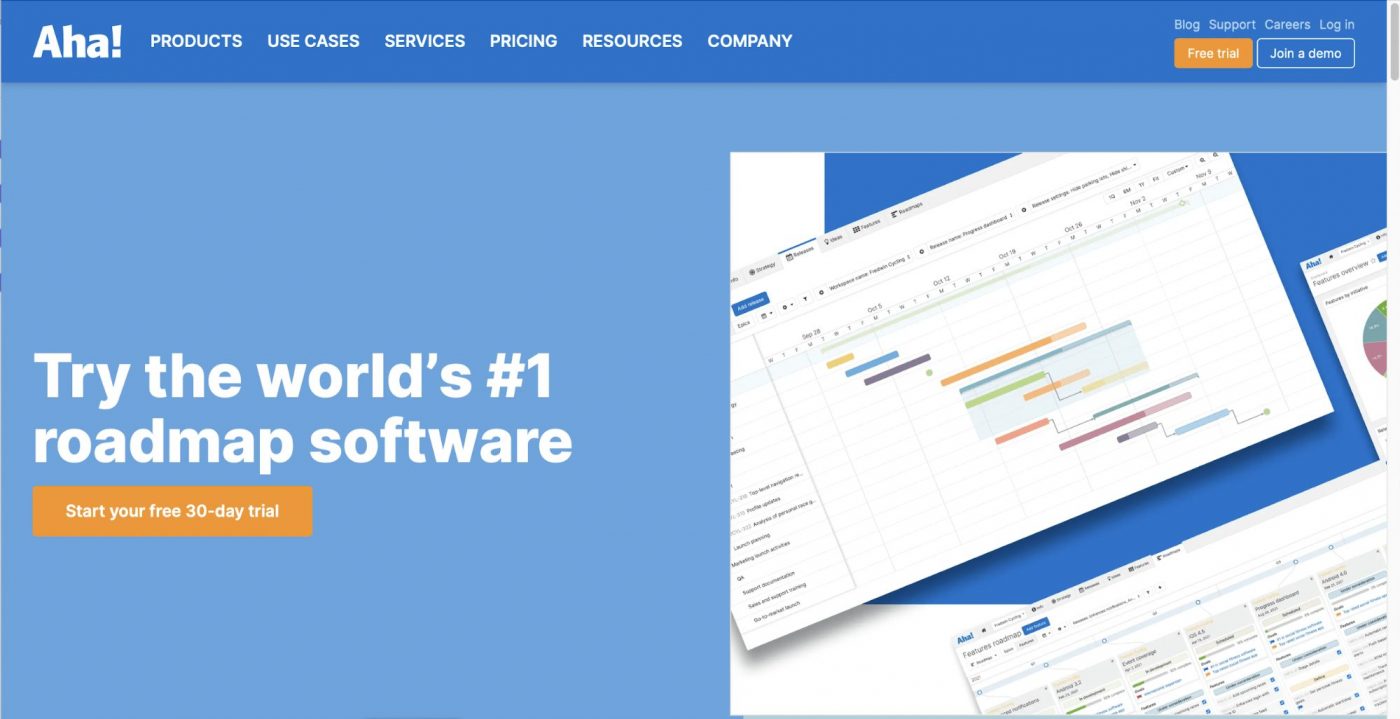
يمكن أن يساعد برنامج Aha! أي مدير المنتج على فهم لماذا ومتى وماذا لمنتجاتهم لجعل إدارة المنتج سهلة.
في جوهرها، تحاول أن تجعل مشروعك مليئًا بلحظات "Aha!" التي نحبها جميعًا! 😜
هذا خارطة طريق المنتج تقدم المنصة عدة أدوات لـ
- إدارة المحفظة
- إدارة المتطلبات
- تخطيط استراتيجية التسويق%ref/
- إدارة الإصدار
- إطار استراتيجية المنتج إنشاء
- إدارة الأفكار
- إنشاء خارطة طريق مرئية
وحتى مع كل هذه الوظائف، فإن Aha! ليست هنا لتستحوذ على مساحتك.
فالبرنامج يستخدم السحابة لإعداد الملفات وحفظ المحادثات، بحيث لا يتم المساس بمساحة تخزين جهازك.
بالإضافة إلى ذلك، تتيح لك ميزاته تحديد كل ما ستحتاج إليه حتى قبل إنشاء المنتج.
ولكن قبل أن تقول آها! دعنا نتحقق من ميزاته الرئيسية.
4 ميزات رئيسية لـ Aha!
فيما يلي أهم أربع ميزات رئيسية لـ Aha!
1. الميزات
أوقف الارتباك
هذه ميزة تسمى 'ميزات، وهي وحدات عمل أساسية في Aha!
(ليست تسمية ذكية حقًا، أليس كذلك؟) (ليست تسمية ذكية حقًا، أليس كذلك؟)
تمثل الميزات مهمة أو عنصر عمل يجب عليك إكماله لتحقيق خططك الاستراتيجية.
لذا، إذا كانت استراتيجيتك هي إنهاء مشاهدة The Walking Dead بحلول نهاية الأسبوع، يمكن أن تكون كل حلقة ميزة!
لإبقاء كل من يعمل على ميزاتك على اطلاع، يمكنك ربطها مباشرةً بـ
- الأهداف الاستراتيجية
- مبادرة
- فكرة
- ملاحظات
- إصدار منتج
- والمزيد
سيخبرهم ذلك بسياق الميزة وأهميتها. سيعرفون أيضًا كيف يساهمون في استراتيجية منتجك الرائعة.
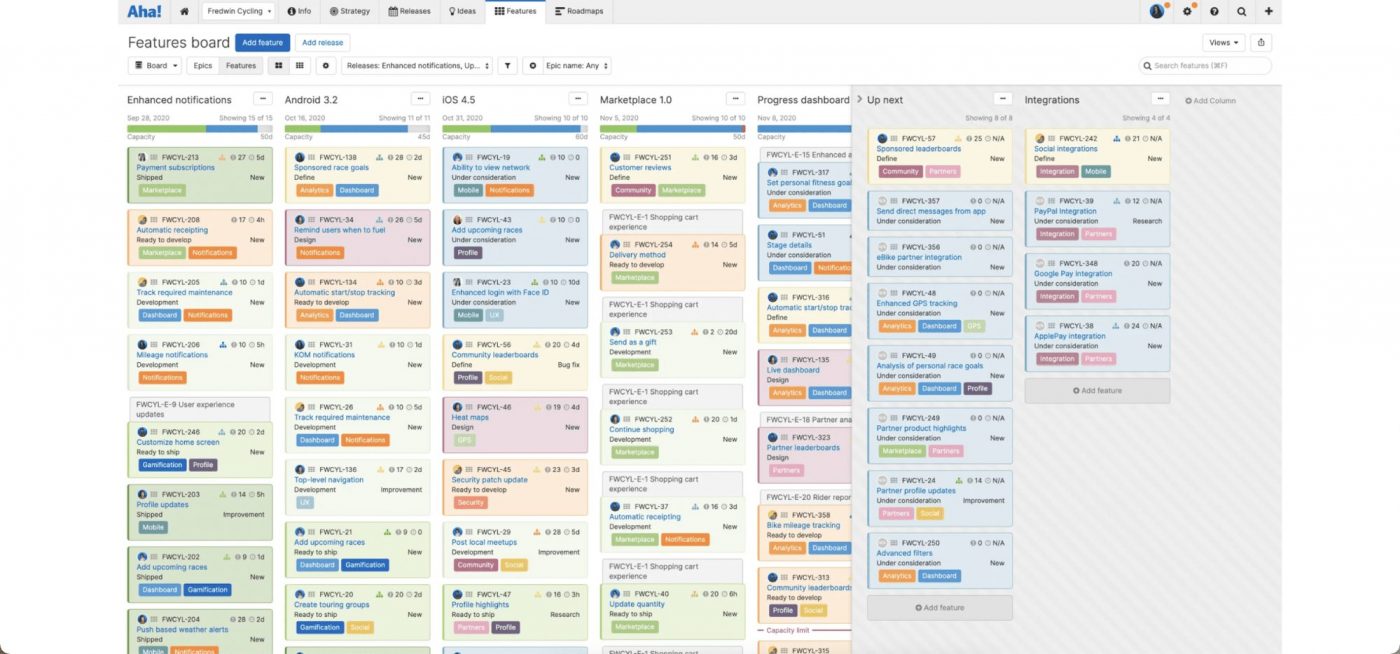
2. خرائط الطريق
لا يمكن أن تكتمل مراجعة إدارة منتج Aha دون ذكر خرائط الطريق .
الأمر أشبه بالحديث عن Netflix دون مناقشة فيلم أصلي واحد على الأقل من Netflix.

تعد خرائط الطريق طريقة رائعة لـ تصور وتوصيل وجهة منتجك أو حملتك أو خدمتك. فهو يمنحك رؤية عالية المستوى لخطتك الاستراتيجية التي تساعدك على تحديد الأهداف والحفاظ على وضوح التواصل.
يتيح لك Aha! إضافة البيانات، مثل الجدول الزمني أو الاستراتيجية، لإنشاء خريطة طريق استراتيجية واختيار ما إذا كنت تريد تصورها كمخطط جانت أو تقويم أو تقويم أو بداية أو خريطة طريق مخصصة.
يمكنك بعد ذلك مشاركة النسخة المباشرة من خارطة الطريق مع فريق المنتج الخاص بك لسهولة التعاون.
3. التعاون
في Aha! تحصل في Aha! على تحرير تعاوني في الوقت الفعلي.
لذلك عندما يقوم العديد من الأشخاص بتحرير الملاحظات أو حقول الوصف، يمكنك رؤية أسماء المشاركين الآخرين كعلامات. تتحرك الأعلام في الوقت الفعلي، مما يساعد على ضمان الشفافية و التعاون الفعال .

علاوةً على ذلك، تحتوي كل وظيفة رئيسية في البرنامج، مثل الميزات والملاحم والمبادرات، على قسم تعليقات حيث يمكنك التواصل مع فريقك أثناء العمل.
إنه يشبه برنامج Teleparty (المعروف سابقًا باسم Netflix Party)، حيث يمكنك مشاهدة نفس العرض أو الفيلم مع أصدقائك الذين يعيشون بعيدًا أثناء التحدث في الوقت الفعلي. 🎥🍿💬
هذا أداة التعاون تتيح لك أيضًا مشاركة خطط مرئية جميلة ، مثل الجداول الزمنية، لتنسيق عبر الوظائف عمل الفريق في مكان واحد.
4. التكامل
هل تعرف كيف أنك عندما تبحث عن فيلم على Netflix، يظهر لك في اقتراح البحث؟ ثم تقوم باختياره لتكتشف أنه غير موجود بسبب القيود الإقليمية؟ \ تنهدات في الارتباط\

من المحتمل أنك لن تواجه هذه الحسرة عند البحث عن Aha! التكاملات.
يتكامل Aha! مع العديد من الأدوات للتطوير وإدارة المشاريع والتعاون وإدارة علاقات العملاء والدعم.
تتضمن بعض عمليات التكامل الشائعة ما يلي:
- تحليلات جوجل
- المتتبع المحوري
- جيرا
- Azure DevOps
الآن بعد أن تعرفت على ميزات Aha! الميزات الرئيسية، دعنا ننتقل إلى الحلقة التالية، "_مزايا Aha!
3 مزايا رئيسية لإدارة منتجات Aha!
فيما يلي ثلاث مزايا رئيسية لإدارة منتجات Aha:
1. سهولة إدارة المنتج لتقديم ما يريده العملاء إدارة المنتج سهلة للغاية على Aha! حيث تتيح لك وضع استراتيجية والتقاط أفكار العملاء والاهتمام بالميزات.
كما أنه يحتوي أيضًا على فكرة 💡 بوابة، وهي تشبه نوعًا ما صفحة مساعدة Netflix حيث تقترح عليهم الأفلام والعروض لإضافتها.
باستثناء، هنا، البوابة لك.
أنت تجمع وتدير كل فكرة يرسلها المستخدمون.
يمكنك أيضًا الحصول على قصة المستخدم خرائط لتصور وترتيب أولويات العمل الذي سيبني تجربة المستخدم التي يرغب فيها عملاؤك.
أثناء رسم خرائط قصة المستخدم، يمكن لفريقك إنشاء مخطط تفصيلي قوي لتفاعلات المستخدم التمثيلي مع منتجك وتقييم الخطوات التي تفيد المستخدم أكثر من غيرها. سيعمل ذلك مثل التغذية الراجعة ويساعدك على تبسيط إدارة المنتج.
2. يسمح بالتخطيط الفعال للتسويق
في Aha! في Aha! يمكن لفريق التسويق الخاص بك رؤية جميع البرامج والحملات في مكان واحد. وهذا يجعل من السهل تنسيق أنشطتهم التسويقية على مختلف المستويات.
يبدو الأمر وكأن فريقك هو صديقك على Netflix، وأنت تشاركهم نفس الحساب لأنه ليس لديك ما تخفيه.
أنت التخطيط التسويقي يمكن أن يكون سهلًا مع أدوات Aha! التي تتيح لك
- وصف جميع الأنشطة التسويقية
- تعيين المهام
- تتبع التبعيات
- التعاون في التسليمات
- تبسيط عملية الموافقة
هل تريد إلقاء نظرة عن كثب على كيفية عمل عملية التخطيط؟
تفقد موقعنا تفصيل خطوة بخطوة لعملية التخطيط التسويقي .
3. يمكن تخصيص الأداة لاحتياجاتك
ما فعلته Netflix بعروضها الإجرامية، فعلته Aha! بقدرات التخصيص.
هناك العديد من الخيارات، وكلها لديها ما تقدمه!
إليك لمحة صغيرة عما يمكنك تخصيصه في Aha!
- الحالات
- الحقول
- سير العمل
- التخطيطات
- الجداول
- والمزيد!
ومع ذلك، فإن السؤال الأهم هو: هل هذا هو برنامج خارطة الطريق مناسب لك؟
5 قيود على إدارة منتجات Aha (مع الحلول)
دعونا نترك الأخطار لعروض نيتفليكس وليس لـ برنامج إدارة المنتجات .
لذلك في مراجعة إدارة منتجات Aha هذه، دعنا نرى أين يقع Aha!
1. ميزة الملاحظات المحدودة
يحتوي Aha! على ميزة الملاحظات التي تتيح لك:
- إنشاء ملاحظة فارغة
- إنشاء قالب ملاحظة
- مشاركة ملاحظاتك وتصديرها
- تنظيم ملاحظاتك والمزيد
يبدو الأمر معقداً للغاية بالنسبة لشيء اسمه "ملاحظات" فقط
ولكن عندما يتعلق الأمر بوضع الملاحظات في العمل، فإن Aha!
لا يمكنك إنشاء مهام من ملاحظاتك. لا يمكنك حتى إضافة قائمة مرجعية بسيطة.

دعونا ننهي الإحراج.
قل مرحباً لـ انقر فوق . إنها واحدة من الأعلى تصنيفًا أداة إدارة المشاريع، المفضلة لدى الكثيرين فرق العمل في الشركات الصغيرة والمتوسطة والكبيرة .
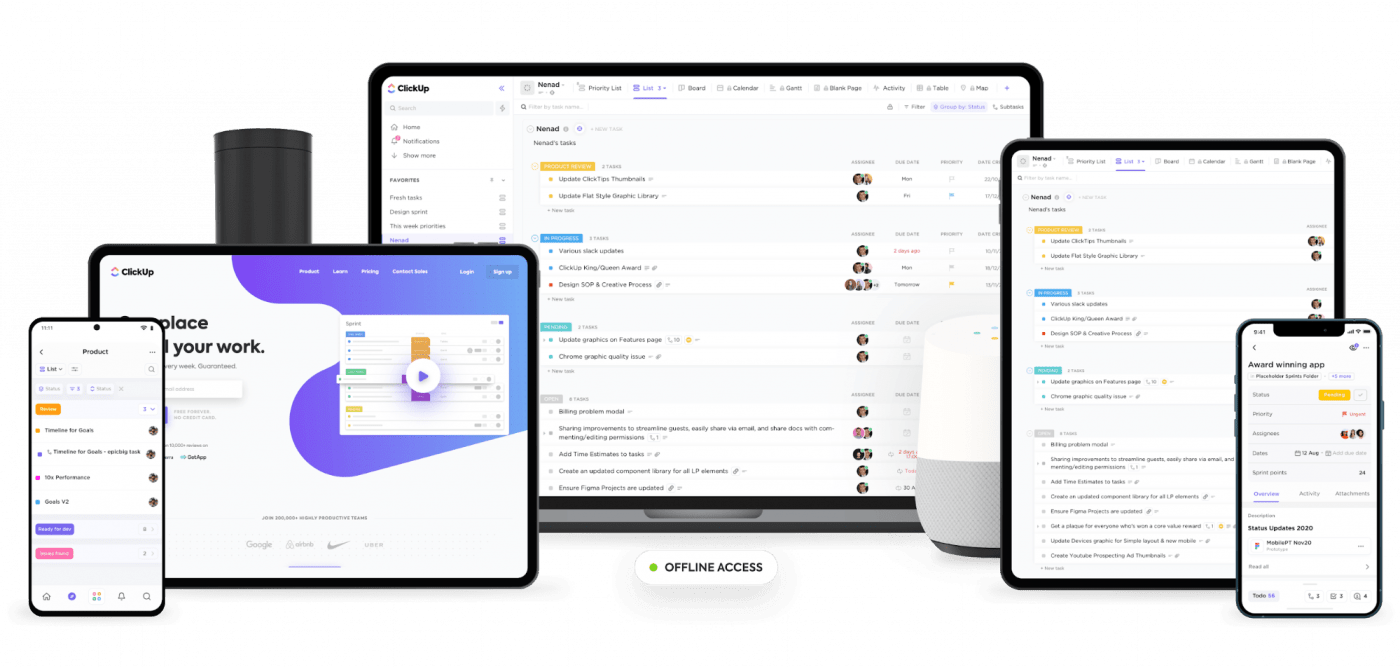
حل ClickUp #1: المفكرة يعد تدوين الملاحظات في ClickUp هادفًا أكثر من تدوين الملاحظات في Aha!
استخدم المفكرة لإنشاء ملاحظات يمكنك بسهولة تحويلها إلى مهام في ثوانٍ
إليك كيفية عمل ذلك:
- يصبح عنوان ملاحظتك اسم المهمة
- يصبح محتوى الملاحظة هو وصف المهمة
- أضف التفاصيل المناسبة قبل حفظها
وعلى عكس Aha! ، يتيح لك ClickUp أيضًا إنشاء قوائم مراجعة في ملاحظاتك.
حل ClickUp #2: المستندات عندما لا تكفي الملاحظات، إلى أين تذهب؟
لدى ClickUp المكان المناسب لذلك: المستندات.
هنا، يمكنك إنشاء قواعد بيانات كبيرة مثل ميثاق المشروع المستندات, سير العمل العمليات، وتعليمات التأهيل، والعقود، وغير ذلك الكثير.
يقوم ClickUp تلقائياً بتخزين مستنداتك إلى جانب مشاريعك للوصول السريع إليها.
كما يقدم ميزات أخرى مثل:
- عدد الكلمات
- المشاركة والأذونات
- بطاقات الإشارات المرجعية لمواقع الويب
- والمزيد!
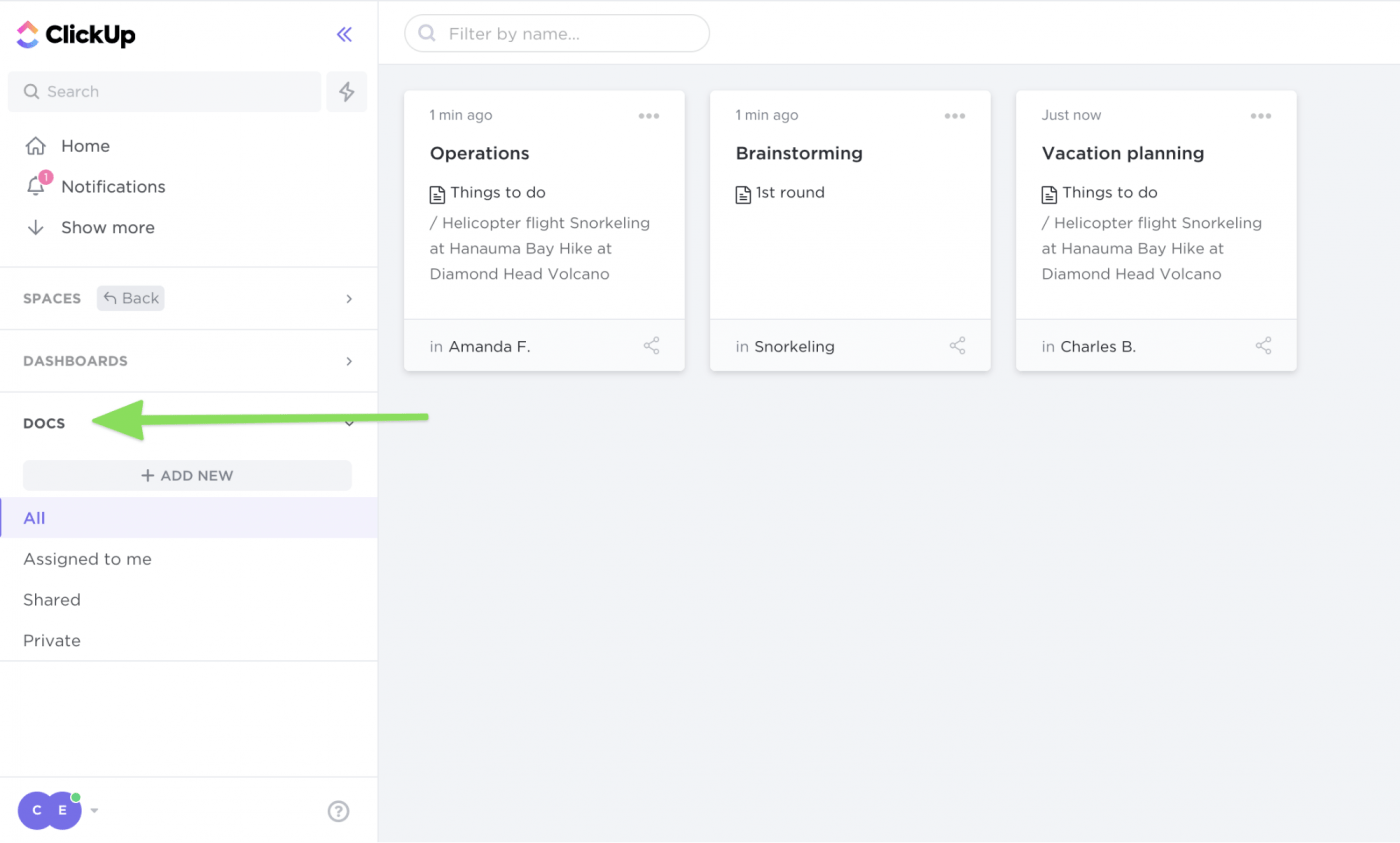
2. لا توجد خرائط ذهنية
بالنسبة لأداة إدارة المنتجات، يضغط Aha! نوعًا ما على زر تخطي المقدمة لميزة تخطيط مهمة جدًا.
لا تحتوي على خريطة ذهنية أو أي نوع من ميزات السبورة لرسم خططك، على ما نعتقد.
حل ClickUp: الخرائط الذهنية A
الخريطة الذهنية هي أداة مرئية تستخدم مخططات هرمية حول مفهوم مركزي. وهذا يجعل من السهل العصف الذهني لجميع أنواع تخطيط المشاريع .
على ClickUp، يمكنك وضع رسوماتك في العمل.
_كيف؟
يتيح لك وضع المهام سحب وإسقاط الفروع لإعادة ترتيب مساحة العمل الخاصة بك. يمكنك حتى إنشاء المهام أو حذفها أو تعديلها هنا.
تخيل الوقت الذي يمكنك توفيره أثناء تخطيط وإنشاء المهام في نفس الوقت.
لذلك لديك المزيد من الوقت لـ..

لا تريد أي علاقة بالمهام أو مساحة العمل البنية؟
استخدم الوضع الفارغ وارسم أفكارك كما يحلو لك.
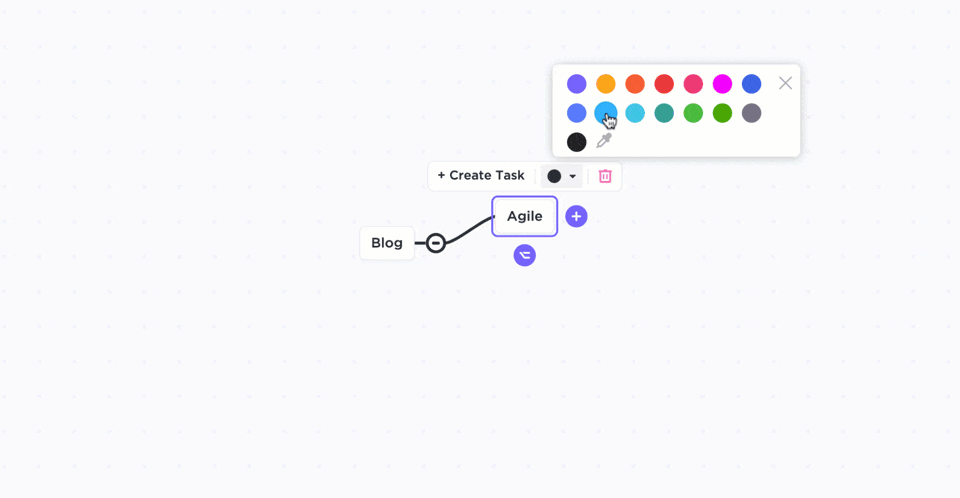
3. لا يوجد متتبع للوقت الحقيقي
في Aha! يمكنك تسجيل وقت العمل في حقل "تقدير" بالنقر على "تسجيل الوقت"
ولكن أين يذهب الوقت بالضبط؟
_كيف يمكنك معرفة ما إذا كنت قد عملت لمدة ساعة وحان وقت الاستراحة التي تستغرق حلقة واحدة؟
لا توجد طريقة لتتبع الوقت لمهام محددة في الوقت الفعلي ما لم تتكامل مع تطبيقات تتبع الوقت.
لماذا تفعل ذلك بينما يمكن لبرنامج مثل ClickUp القيام بذلك دون دعم خارجي؟ مقارنة Aha! مقابل. Jira !
حل ClickUp #1: متتبع الوقت الأصلي عندما تقوم بتمكين تتبع الوقت
انقر فوق التطبيق في المساحة , يمكنك البدء في تتبع الوقت لجميع مهامك.
ابدأ تشغيل متتبع الوقت الأصلي وأوقفه وقتما تشاء، تمامًا مثل تشغيل العروض على Netflix وإيقافها مؤقتًا. _ناهيك عن صوت افتتاح نيتفليكس """نيتفليكس تو دوم"* 😛

يمكنك أيضًا الحصول على رؤى وإنشاء تقارير عن الوقت المتتبع باستخدام أدوات تتبع الوقت على لوحة التحكم . تتيح لك التقارير الزمنية الاطلاع على الساعات التي قضاها الموظفون في العمل مما يجعل يوم الدفع سهلاً. ـ
المكافأة: كيفية استخدام تتبع الوقت لإنهاء المشاريع بشكل أسرع.
ClickUp الحل رقم 2: تتبع الوقت التكامل هل لديك بالفعل تطبيق مفضل لتتبع الوقت؟
يتكامل ClickUp بسهولة مع العديد من تطبيقات تتبع الوقت، بما في ذلك تايم دكتور , إيفرهور , توجل إلخ. حتى تتمكن من تتبع الوقت الذي تقضيه في أنشطة ومشاريع ClickUp المختلفة بسهولة.
إذا كان فريقك يؤدي العمل عن بُعد ، سيضيف هذا أيضًا إحساسًا بالمساءلة.
ومع ذلك، لا يقتصر الأمر على تتبع الوقت فقط.
يحتوي ClickUp على خيارات تكامل أخرى أيضًا من أجل
- تطبيقات التواصل (سلاك)
- تطبيقات جمع ملاحظات العملاء (رد المستخدم)
- تطبيقات التخزين (جوجل درايف)
- والمزيد!
4. لا يمكن التعليق على ملف PDF
إذا كنت تستخدم Aha! وضع تعليقات توضيحية لملفات PDF .
وهذا يعني أنه في كل مرة تحصل فيها على تعليقات على ملف PDF، سيتعين عليك تنزيله والتعليق عليه بأداة مختلفة، ثم مشاركته مع منشئي المحتوى.
تخيل الوقت الضائع. ⏰
والأهم من ذلك، هذه ليست طريقة للتعاون. ألا يجب أن تكون بحاجة إلى شيء يشجع على المشاركة السلسة في التغذية الراجعة والإبداع المشترك؟
حل ClickUp: شرح PDF باستخدام التعليق، يمكنك وضع تعليقات توضيحية لملفات PDF عن طريق تمييز العلامات التي تحتاج إليها.
يمكنك إضافة تعليقات حيث تريد التغيير وتعيينه إلى شخص معين لتنفيذ التغيير.
يعد التدقيق في ClickUp رائعًا لترميز الصور حيث يمكنك وضع علامات واضحة على نماذج التصميم حيث تريد إجراء تعديلات.
5. باهظة الثمن
أكبر مفسد للصفقات هو سعر Aha!
لديهم خطتان
- خطة بدء التشغيل للشركات التي يقل عمرها عن 18 شهرًا، ولديها تمويل أقل من 1.5 مليون دولار أمريكي، ولديها أقل من 10 موظفين
- خطة ممتازة تبدأ من 59 دولارًا لكل مستخدم شهريًا
نعم، إنها باهظة الثمن بشكل مذهل نوعاً ما.
حل ClickUp: خطة مجانية للأبد
على عكس Aha! ، فإن ClickUp لديه خطة مجانية للأبد. بدون مقابل!
لذا، سواء كنت تدير شركة ناشئة أو شركة، يمكنك الحصول على ClickUp بدون مقابل.
يمكن أن يكون اشتراكك في Netflix هو المصاريف الوحيدة. على الرحب والسعة 😇 😇
وخططنا المدفوعة في متناول جميع أحجام الفرق. ألقِ نظرة:
- غير محدودة (5 دولارات/ مستخدم شهرياً):
- المحافظ
- مهمة متكررة مستقبلية متكررة في التقويم
- مشاهدات غير محدودة
- والمزيد
- العمل (9 دولارات مستخدم شهرياً):
- حدود العمل قيد التنفيذ
- معرّف مهمة مخصص
- فريق دعم 24/7
- والمزيد
لم ننتهي بعد!
لدى ClickUp الكثير من
الميزات
التي يمكنها القيام بما يستطيع Aha! وأكثر من ذلك.
إليك نظرة سريعة على بعضها:
- إرسال واستقبال رسائل البريد الإلكتروني على ClickUp باستخدامالبريد الإلكتروني ClickApp
- ابحث عن دعمتريلو,أساناوجيرا التكامل
- تعيين وتتبعالتبعيات علىمخطط جانت عرض
- أتمتة
المهام المتكررة باستخدامالمشغلات,الإجراءاتوالشروط
- تعيين مهمة واحدة إلىتعيينات متعددة أو حتى مهمة كاملةفريق
- استخدام قوالب الفريق لـإدارة المنتج,القانون,إدارة علاقات العملاءإلخ.
- تعيين مهمة واحدة إلىتعيينات متعددة أو حتى مهمة كاملةفريق
ذات صلة:_
_/مرجع/ /مدونة؟ ص=44370 أسئلة المقابلة الشخصية لمدير المنتج *%/%href/_
هل لدى Aha! عامل Aha؟
من الواضح من مراجعة إدارة منتجات Aha هذه أن Aha! هي أداة جيدة.
ولكن دائمًا ما تكون الأشياء الصغيرة هي التي تنجح أو تفسد الصفقة.
باهظة الثمن. لا يوجد وضع غير متصل بالإنترنت. لا توجد خرائط ذهنية.
هذه الأشياء تجعل Aha! حزمة أقل من كاملة.
إذا كنت بحاجة إلى أداة يمكنها القيام بكل ذلك (وأكثر)، فإن الحل هو ClickUp!
إنها أداة قوية أداة إدارة المشاريع التي يمكن أن تكون المهمة , مستند , المورد و مدير الوقت في نفس الوقت
إذن انضم إلى ClickUp مجانًا اليوم واستعد لأفضل موسم من "إدارة المنتجات" حتى الآن!


